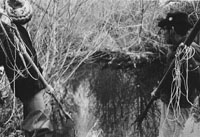First Nations fishermen sometimes used harpoons and spears to catch salmon. These tools
were most effective in certain environments and under specific river conditions. For instance,
harpoons and spears worked best in streams and rivers where the water was clear. They were also
used in bays and inlets where large numbers of salmon would gather before moving into the
rivers for their upstream migrations. Both the harpoon and spear
required great skill to be used efficiently and effectively. During earlier times, when thousands of
salmon could be seen swimming up BC rivers, the use of both harpoons and spears could bring
in a large number of the salmon needed for the winter.
Two men harpooning salmon near
the mouth of the Cowichan River.
© RBCM pn55051-6
 |
There are several differences between harpoons and spears. For instance, harpoons could be
either hurled or used to stab fish while spears were only used for stabbing (some harpoons had
handgrips to give better traction when thrown). Harpoons were also considerably longer and
more strongly built than spears. They were therefore used to catch the larger species of salmon,
such as the Spring. With the assistance of a canoe, and flares to see by, harpoons could be used at
night to catch fish.
Furthermore, harpoon points were connected to the shaft by
a line or cord, and were designed to separate from the shaft when a fish was struck. Some
harpoons had up to three detachable heads. The Lekwiltok peoples of the Campbell River area
used a type of harpoon that had three heads on it. The detachable point allowed an impaled
salmon to struggle without damaging the gear. Fishermen retrieved the impaled salmon by
pulling on the line.
In contrast, spear points were firmly attached to the shaft. Often, the points on the end of a
spear were barbed to hold the salmon more firmly. Since a spear never left the fisherman's hand, it was
used in conjunction with traps, dams, or in canyons, where salmon were concentrated into one
area and easily flipped onto a bank or into a canoe.
The use and structure of harpoons and spears differed, but they were made out of similar
materials. The shafts of both were made out of cedar, pine or other varieties of wood selected
for their lightweight qualities. Harpoon and spear points were made of wood, slate, antler, or bone, and later, metal. Cherry bark was often used to
fasten the points to the shafts.
Top of page.



